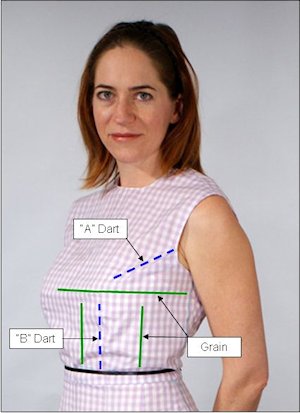|
Patternmaking & Sewing Notes
by Don McCunn
How to Make Sewing Patterns
Update: Gingham & The Woman's Front Sloper
I wrote my book, How to Make Sewing Patterns, back in 1977 and have been asked if I had plans to revise it. There are only two basic things I do differently today than when I wrote the book. These are now included in the 2016 edition.
The two things I do differently are I use gingham for fitting the bodice and skirt. And I have revised how I draft the woman's front bodice pattern.
Gingham for Fitting:
When I was teaching Pattern Design at San Francisco Community College Adult Education Division back in the 70s I would stress the importance of looking at the grain of the fabric to determine whether the fit was correct. As we were using muslin, I would carry around a magnifying glass so that people could clearly identify the direction of the grain.
Then one day I was in the fabric store. When I walked past the display of gingham, I did a double take. The woven pattern of the different colors of threads in the gingham made the grain jump out. It was so easy to see what was happening to the grain as it is shaped on the three-dimensional human body I knew I had found the perfect fabric to achieve super accurate fittings. This helps to achieve accurate fits within an 1/8".
Woman's Front Bodice Pattern:
Throughout my book I show how to draft the initial patterns without any darts. I do this because nature never repeats the same shape twice. So it is my contention you will never be able to determine the size, location, or length of darts accurately from measurements. If there were corners and sharp angles in the human body, maybe you could take accurate measurements. But the human body is a series of continuously changing contours. From what I have heard even body scans using sophisticated equipment cannot accurately create a two dimensional representation of an individual's body from the measurements they take.
The one exception to "no darts" in my book is that I show how to draft a woman's front using a dart. Once again when I was teaching back in the 70s I had large class sizes and lots of bodies who were willing to helping me develop data. So I came up with a chart for how to adjust the woman's bodice pattern based on the difference between the full bust and above bust measurements.
But the chart does not cover the full range of possible bust sizes. But more than that, it creates a pattern that has a bust to waist side panel that is tricky to design from. It is essentially off grain. So what I do now is draft the woman's front pattern without a dart. It creates the size you need so that you can establish a very accurate dart in a fitting.
I have a PDF file with the two revised pages for this draft which you can download and print out to revise the drafting procedure in the first edition of my book: Women's Front Bodice Pattern Draft.
To fit this pattern I use a dart into the armscye for the above the bust shape, the "A" Dart, and a dart to the waist to establish the below the bust shape, the "B" Dart. What this fitting procedure does is it allows you to use the horizontal grain around the full bust to create a very accurate "A" dart. You can then adjust the "B" dart to ensure that the vertical grain of the fabric is correct at both the center front and on the side of the body.

With the sloper designed in this way, whatever design lines you draw for the side of the body can be envisioned as they relate to the horizontal grain.
|